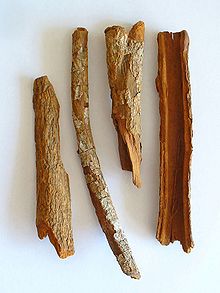
Back كينين Arabic کوینین AZB Хінін Byelorussian Хинин Bulgarian কুইনিন Bengali/Bangla Quinina Catalan Chinin Czech Cwinin Welsh Kinin Danish Chinin German

Quinine [1] is an alkaloid which can reduce fever, work against malaria, pain and swelling. The bark of the Cinchona family of trees contains quinine. Quinine can be made artificially, but this is more expensive than extracting it from the bark of the tree. This tree is found in the Andes, South America, Indonesia, and Congo.
Quinine was the first treatment for malaria, known from 1631 in Europe,[2][3] and probably much earlier to the native peoples of South America. Even today, quinine is used to treat certain forms of malaria, when other drugs fail or are unavailable. In that way, quinine is currently one of the best treatments for malaria tropica, which is caused by plasmodium falciparum. For the other forms of malaria, quinine is no longer used, as other drugs have replaced it.
- ↑ English pronunciation: /ˈkwaɪnaɪn, kwɪˈniːn, ˈkwiːniːn/
- ↑ Cite error: The named reference
Roccowas used but no text was provided for refs named (see the help page). - ↑ Medawar P.B. & J.S. 1983. Aristotle to zoos: a philosophical dictionary of biology. Harvard, p179. ISBN 0-674-04537-8